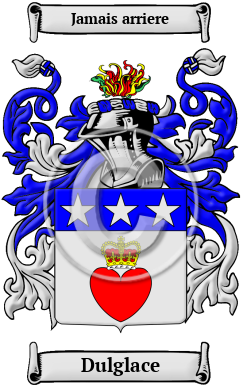| ![Show Contents]() Dulglace History, Family Crest & Coats of Arms Dulglace History, Family Crest & Coats of Arms
- Origins Available:
Scotland
Ireland
Etymology of DulglaceWhat does the name Dulglace mean? In Scottish history, few names go farther back than Dulglace, whose ancestors lived among the clans of the Pictish tribe. The ancestors of the Dulglace family lived in Moray, where the family has a long and distinguished history dating back to early times. Some claim the name is derived from a knight of 770 who after aiding King Solvathius of Scotland in his great battle with Donald Bain, King of the Western Isles was granted the lands of Clydesdale. Others claim the name was originally derived from Theobaldus, a Flemming and were granted the lands of Douglas Water. In Gaelic, the name is Dudhglas means "black stream." 1 Dulglace Coat of Arms CreationIn the arms of nearly every branch of the Douglas family is a human heart imperially crowned, in remembrance of the good Sir James Douglas, who was commissioned to carry the heart of Robert Bruce to Jerusalem, and died fighting the Moors in Spain. When he saw himself surrounded, he threw the King's heart in its silver casket into the ranks of the enemy, saying, "Pass first in fight, as thou wert wont, Douglas will follow thee or die." 2 Early Origins of the Dulglace familyThe surname Dulglace was first found in Moray, where the progenitor of the Clan is thought to be Archibald of Douglasdale (1198-1239). The Douglasses of Drumlanrig claim descent from Sir William Douglas, who was granted the lands of Drumlanrig in 1412 by King James I. The grandson of Archibald Douglasdale, known as William the Hardy, served as a companion-in-arms to William Wallace, the patriot leader of the Scottish wars of Independence. His two sons carried on his noble reputation. The first, William, was the progenitor of the Douglases of Morton and was granted the Earldom of Morton in 1458 by King James II. The second, Andrew, and his family became known as the Black Douglases. 3 Early History of the Dulglace familyThis web page shows only a small excerpt of our Dulglace research. Another 232 words (17 lines of text) covering the years 1174, 1220, 1243, 1274, 1298, 1328, 1360, 1380, 1400, 1402, 1403, 1404, 1408, 1540, 1594, 1595, 1611, 1662, 1674 and 1890 are included under the topic Early Dulglace History in all our PDF Extended History products and printed products wherever possible. Dulglace Spelling VariationsAlthough Medieval Scotland lacked a basic set of spelling rules, which meant that scribes recorded names according to their sounds it was not uncommon for the names of a father and son to be recorded differently. As a result, there are many spelling variations of Scottish single names. Dulglace has been written Douglas, Douglass, Dougliss, Dougless, Dowglas, Duglas, Duglass and many more. Early Notables of the Dulglace familyNotable amongst the Clan at this time was Archibald Douglas, (1328-1400), 3rd Earl of Douglas, Earl of Wigtown, Lord of Douglas, Lord of Bothwell and Lord of Galloway, a late medieval Scottish magnate; George Douglas, 1st Earl of Angus (1380-1403), mediaeval Scottish nobleman; Isabel Douglas, Countess of Mar (c. 1360-1408), inherited most of brothers property, excluding only the Douglas lands which could only pass through the male line, she became the most sought after bride in the realm and soon was married to Sir Malcolm Drummond, marriage however failed to produce any children and the Countess soon became the focus of...
Another 354 words (25 lines of text) are included under the topic Early Dulglace Notables in all our PDF Extended History products and printed products wherever possible. Migration of the Dulglace family to IrelandSome of the Dulglace family moved to Ireland, but this topic is not covered in this excerpt.
Another 59 words (4 lines of text) about their life in Ireland is included in all our PDF Extended History products and printed products wherever possible. Migration of the Dulglace familyThousands of Scots left their home country to travel to Ireland or Australia, or to cross the Atlantic for the North American colonies. The difficult crossing was an enormous hurdle, but those who survived found freedom and opportunity in ample measure. Some Scots even fought for their freedom in the American War of Independence. This century, their ancestors have become aware of the illustrious history of the Scots in North America and at home through Clan societies and other organizations. Passenger and immigration lists show many early and influential immigrants bearing the name Dulglace: Charles Douglas who settled in New Jersey in 1685; Hugh Douglas settled in Virginia in 1635; John Douglas settled in Virginia in 1655; Lee William Douglas settled in Virginia in 1655.
| Dulglace Motto and War Cry | + |
The motto was originally a war cry or slogan. Mottoes first began to be shown with arms in the 14th and 15th centuries, but were not in general use until the 17th century. Thus the oldest coats of arms generally do not include a motto. Mottoes seldom form part of the grant of arms: Under most heraldic authorities, a motto is an optional component of the coat of arms, and can be added to or changed at will; many families have chosen not to display a motto.
Motto: Jamais arriere
Motto Translation: Never behind.
War Cry: "A Douglas ! A Douglas !"
- Black, George F., The Surnames of Scotland Their Origin, Meaning and History. New York: New York Public Library, 1946. Print. (ISBN 0-87104-172-3)
- Polson, Alexander, The Romance of Scottish Crests and Mottoes. Inverness: Walter Alexander, Inglis Street 1929. Print
- Smith, George (ed), Dictionary of National Biography. London: Smith, Elder & Co., 1885-1900. Print
 |

